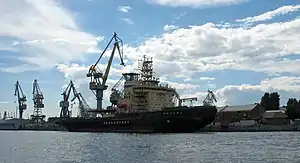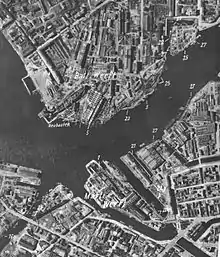Baltic Shipyard
The OJSC Baltic Shipyard (Baltiysky Zavod, formerly Shipyard 189) (Russian: Балтийский завод имени С. Орджоникидзе) is one of the oldest shipyards in Russia and is part of United Shipbuilding Corporation today.
| Type | Open joint-stock company |
|---|---|
| Industry | Shipbuilding |
| Founded | 1856 |
| Headquarters | , Russia |
| Revenue | $166 million[1] (2017) |
| -$2.58 million[1] (2017) | |
| $45.9 million[1] (2017) | |
| Total assets | $1.82 billion[1] (2017) |
| Total equity | $41.8 million[1] (2017) |
| Parent | United Shipbuilding Corporation |
| Website | www.bz.ru |



It is located in Saint Petersburg in the south-western part of Vasilievsky Island. It is one of the three shipyards active in Saint Petersburg. Together with the Admiralty Shipyard it has been responsible for building many Imperial Russian battleships as well as Soviet nuclear-powered icebreakers. Currently it specializes in merchant ships while the Admiralty yard specializes in diesel-electric submarines. in addition, it is responsible for construction of Russian floating nuclear power stations.
History
The shipyard was founded in 1856 by the St. Petersburg merchant M. Carr and the Scotsman M. L. MacPherson. It subsequently became the Carr and MacPherson yard.[2] In 1864 it built two monitors of the Uragan class.[2] In 1874 the shipyard was sold to Prince Ochtomski.[2]
In 1934 the shipyard started work on the three prototypes for the S-class submarine, based on a German design produced by the Dutch company Ingenieurskantoor voor Scheepsbouw. The Soviets renamed the shipyard Zavod 189 'im. Sergo Ordzhonikidze' on 30 December 1936.
At the time of the collapse of Vladimir Vinogradov's Inkombank during the 1998 Financial crisis, Inkombank held a 16% stake in Baltic Shipyard.[3][4]
See also
- Peresvet-class battleship
- Borodino-class battleship
- Borodino-class battlecruiser
- Andrei Pervozvanny-class battleship
- Gangut-class battleship
- Kronshtadt-class battlecruiser
- Sverdlov-class cruiser
- Russian battlecruiser Petr Velikiy
- Taimyr-class nuclear icebreaker
- Dekabrist-class submarine
- Baltijos Laivų Statykla in Lithuania
- Arktika-class icebreaker
- Admiralty Shipyard
- Severnaya Verf
- Russian floating nuclear power station
References
- http://e-disclosure.ru/portal/files.aspx?id=5552&type=3.
- Polmar, Norman; Noot, Jurrien (1991). "Submarine building yards". Submarines of the Russian and Soviet Navies, 1718-1990 (Google Books) (illustrated ed.). Naval Institute Press. pp. 325–326. ISBN 0-87021-570-1. Retrieved 2009-07-05.
- Березанская, Елена (Berezanskaya, Elena); Евстигнеева, Елена (Evstigneeva, Elena); Козырев, Михаил (Kozyrev, Mikhail) (15 May 1999). "Все, что нажито непосильным трудом. Как делили промышленный холдинг Инкомбанка. "Ведомости" провели расследование вывода промышленных активов из Инкомбанка после августовского кризиса 1998 г. Вот его результаты (см. также стр. А1). Банк - отдельно, заводы - отдельно" [Everything that is acquired by back-breaking labor How the industrial holding of Inkombank was divided "Vedomosti" conducted an investigation into the withdrawal of industrial assets from Inkombank after the August 1998 crisis. Here are the results (see also p. A1). Bank - separately, factories - separately]. Vedomosti (in Russian). Archived from the original on 17 May 2001. Retrieved 21 December 2020.
- "Таблица к статье "Все, что нажито непосильным трудом"" [Table to the article "Everything that is acquired by back-breaking labor"]. Vedomosti (in Russian). 15 May 2001. Archived from the original on 17 May 2001. Retrieved 21 December 2020.
External links
- Official website (in Russian)
- Official website (in English)
- Baltiysky Zavod JSC on Federation of American Scientists
- Baltic Shipyard on Nuclear Threat Initiative
